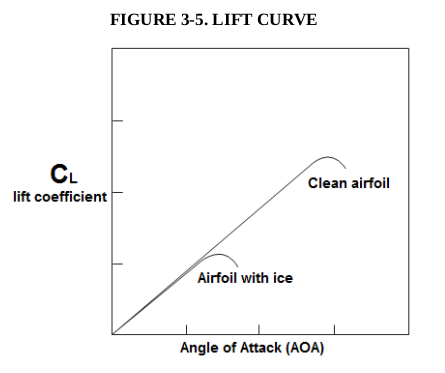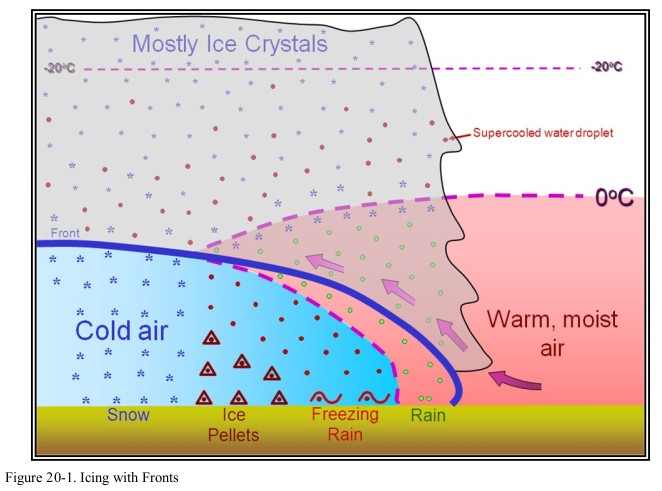Effects of icing in flight
Airplanes can fly because engines produce thrust that propels it forward, and wings produce lift to counteract weight.
A wing is a well-shaped airfoil that can produce lift with minimal drag. If ice accumulates on a wing in flight, that changes the shape of the airfoil, which is then likely to not be as efficient at producing lift. Drag can also increase.
Effects of ice:
 Adapted from "Aviation Weather For Pilots and Flight Operations Personnel", AC 00-6A (Cancelled) faa.gov
Adapted from "Aviation Weather For Pilots and Flight Operations Personnel", AC 00-6A (Cancelled) faa.gov
Public domain image by Donald Cook.
Note that "Aviation Weather Handbook", FAA-H-8083-28 faa.gov states:
The actual weight of ice on an airplane is insignificant when compared to the airflow disruption it causes.
The lift an airfoil can produce is affected by the "Angle of Attack" of the wing with respect to the air motion over it.

Public domain image by Donald Cook.
The coefficient of lift (Cl) is a non-dimensional measure of lift, and is proportional to lift. Lift generally increases with angle of attack. However, at some angle, the maximum lift is reached, and higher angles produce less lift. This is termed stall. If the angle of attack is not reduced to re-establish adequate lift, the airplane can descend rapidly, and this is a hazardous condition.

from "Pilot Guide: Flight in Icing Conditions", AC 91-74B faa.gov
To some extent, increasing angle of attack can off-set the effects of ice. However, the margin to stall conditions is reduced. In extreme cases, this is hazardous.
Increasing "Airspeed"
(the speed at which the airplane flies relative to the air) can increase lift.
Stall speed is a term for an airspeed that may induce a stall,
as the angle of attack would have to be increased to the maximum level to maintain flight.
With ice on a wing, a higher airspeed can partially off-set the effects of ice.
However, there are limits, as the engine can only produce so much thrust,
and drag increases with airspeed.
Airplane structure has airspeed limits, particularly for deployed features such as flaps.
Also, landing at a very high airspeed can be impractical and hazardous.
Ice can also affect the controllability of the airplane. Control surfaces such as ailerons can be less effective with ice on the wing leading edge. Ice can collect on control surface balance horns and affect the balance, or jamb the motion of the control surface.
Ice protection systems can counter-act these effects and enable safe flight through icing conditions.
Icing weather
Air temperature in the atmosphere tends to decrease with altitude. Air with moisture as water drops and "Vapor" can rise and cool, from a temperature above 0°C (32°F) to below 0°C. This is how many icing clouds form.
The water drops in an icing cloud are liquid at a temperature at or below 0°C (32°F), in what is termed a "Supercooled" state. Almost any disturbance can lead to freezing of the drops. Often (more than half of colder clouds) this happens spontaneously, without an outside influence, and the cloud can become ice crystals rather than liquid water drops.
A scenario at a weather front that can produce supercooled icing conditions:

from "Aviation Weather Handbook", FAA-H-8083-28 faa.gov
The disturbance of most interest to aircraft icing is when a supercooled water drop impinges on the surface of an aircraft moving through the cloud. The water freezes on the aircraft surface and forms ice shapes. This can affect the aerodynamic performance of the aircraft.
Ice crystals from clouds can also affect aircraft. These do not usually cause ice on the wing leadinge edge, but can accumulate in small passages, such as those in air data instruments and some engine components.
High Ice Water Content (HIWC) is a relatively new icing hazard, at least from the standpoint of research and understanding. HIWC refers to high-altitude ice crystals, which may exist in the tops and anvils of cumulonimbus clouds and thunderstorms. Under certain HIWC conditions, turbine engine performance can be affected, including flameouts. Research into HIWC conditions continues as of the writing of this section.
From "Aviation Weather Handbook", FAA-H-8083-28 faa.gov.

From Aviation Weather For Pilots and Flight Operations Personnel. AC 00-6A (Cancelled), 1975. faa.gov
Resources
"ALC-33: Inflight Icing" faasafety.gov
Despite improvements in equipment and forecast technique, inflight icing is a contributing factor in accidents and incidents each year. What are the reasons for these encounters, and what can you as a pilot do to safely manage the risk associated with icing?
In this course you will learn that water does not always freeze at 32° F. or 0° C. You’ll discover which temperatures are most conducive to clear, rime, and mixed icing, and how water content and droplet size relates to icing severity. You may discover that the de-ice or anti-ice equipment on your aircraft cannot always provide adequate protection. You will find tools for evaluating icing conditions before flight, and you'll have the opportunity to understand and learn how to avoid or, if necessary, recover from roll upset and tail stalls caused by structural ice.
"NASA Glenn Beginners Guide to Aeronautics: Guide to Aerodynamics" www1.grc.nasa.gov
A good review for anyone, not just beginners.
Airframe and Engine Icing ntrs.nasa.gov
This is both a presented version of NASA's in-flight icing training aids, and a brief discussion of NASA Glenn's two icing-capable facilities that simulate the airframe and engine icing environments.
aviationweather.gov
See "AIRMETS" that can include icing conditions, as well as other current weather data.
"Aviation Weather Handbook", FAA-H-8083-28 faa.gov
Chapter 20 covers icing.
"Icing" weather.gov
Includes icing intensity definitions.
"Ice Crystal Icing Briefing" flightsafety.org
skybrary.aero/operational-issues/weather
Has an "icing" subcategory.
Related
This is part of The Basics series.